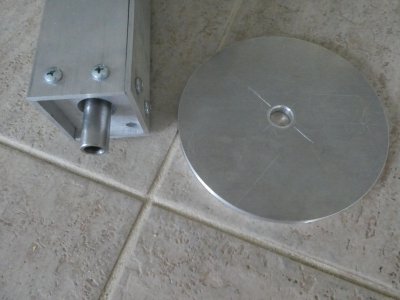The project is to mount the disc square on the shaft with the hole in the center. The shaft is mounted via bearings to the box on the left. It will carry a camera to take astrophotography.
The plan is to turn a collar on a lathe. the collar will machined square on one end, the disc will be mounted square to the collar. The collar will be bored to slip fit to the shaft and set screws to a fix the collar to the shaft.
How is the hole in the disc best bored as close to the center as possible? The objective is one thousands or less.
How is the collar best machined to have a square end to mount the disc square to the bore?
How is the disc mounted on the collar to be center, concentric to the shaft?
I have a SB 9 twith a 4 jar chuck and an RF 30 mill / drill. Both are in good condtion.
I have tried similar tasks in the past and the results only barely passable. I think I have removed and remounted the parts too many times.
Is there an order of machining that would minimize remounts?
The plan is to turn a collar on a lathe. the collar will machined square on one end, the disc will be mounted square to the collar. The collar will be bored to slip fit to the shaft and set screws to a fix the collar to the shaft.
How is the hole in the disc best bored as close to the center as possible? The objective is one thousands or less.
How is the collar best machined to have a square end to mount the disc square to the bore?
How is the disc mounted on the collar to be center, concentric to the shaft?
I have a SB 9 twith a 4 jar chuck and an RF 30 mill / drill. Both are in good condtion.
I have tried similar tasks in the past and the results only barely passable. I think I have removed and remounted the parts too many times.
Is there an order of machining that would minimize remounts?


